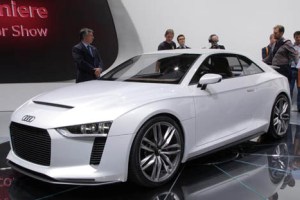
Audi Quattro Concept
Audi Quattro Concept
Audi reinvented the art of rally driving when the all-wheel-drive Quattro racing car arrived in 1980. Incredibly fast, but with the stability that comes from having four driven wheels, the Quattro was a star of the racing world that spawned, in 1984, the equally legendary road-going Sport Quattro. The only strange thing about the Audi Quattro Concept shown in Paris is why it took the German automaker so long to revive the famous model.
An Audi spokesperson explained that the Quattro Concept’s chassis originally began as the platform for an RS 5 coupe. However, the steel structure was replaced with lightweight aluminum, and the wheelbase shortened by 5.9 in. The chunky-looking, 2-passenger Quattro Concept is powered by a longitudinally mounted 400-horsepower 2.5-liter 5-cylinder (borrowed from the Audi TT RS).
If the Quattro makes it to production—which seems highly likely—expect it to fit between the range-topping TT and base versions of the mid-engine R8.
Jaguar C-X75

Jaguar C-X75
We’d love the Jaguar C-X75 even if it were powered by a pair of AA batteries, it’s that good-looking. Incredibly, we overheard some naysayers at the Jaguar stand who questioned the C-X75’s design. Frankly speaking, they’d better visit an optometrist. Jaguar has gotten the shape spot-on with this mid-engine beauty.
Even better, this kitty is more than a pretty face. An electric powertrain is amped up (pun intended) by two gas micro-turbines. Hold on there George Jetson, because the spec sheet only gets better the more you read. The C-X75 has four electric motors—one in each wheel—that deliver the equivalent of 780 bhp and more than 1100 pound-feet of torque.
According to Jaguar’s estimates, the car accelerates from 0 to 62 mph in 3.4 seconds. A 68-mile electric range is boosted by the twin micro-turbines, for a total cruising range of 560 miles. Jaguar officials told us all this tech wizardry is slated for life in a laboratory, at least for several more years of testing.
Lamborghini Sesto Elemento

Lamborghini Sesto Elemento
Raw and rude, the Lamborghini Sesto Elemento showcases the Italian sports car company’s use of carbon fiber. This raucously edgy sports car employs a new type of the lightweight material for its central tub called “forged composite.” Lamborghini has rights to the name and a hoard of patents related to this new material.
Rather than being layered, like traditional carbon fiber, chopped fiber is put into a stamp and (according to Lamborghini officials) the finished chassis tub is complete in only eight minutes. The entire car weighs 2200 lb. It even has carbon-fiber wheels.
A V-10 engine and permanent all-wheel-drive are borrowed from the Gallardo. In terms of overall proportions, the Sesto Elemento has more in common with the “baby Lambo” than the company’s larger, range-topping Murciélago. Lamborghini did coyly tell us it would consider building the Sesto Elemento—strictly a concept car at this writing—so long as the potential owner had deep enough pockets to foot the bill.
Lotus Elite
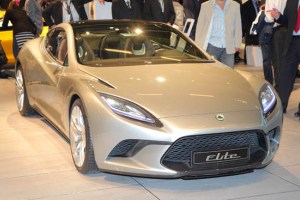
Lotus Elite
We’re still scratching our heads over why Lotus decided all the cars it unveiled in Paris needed some celebrity to help pull off the dust cover. Naomi Campbell, Mickey Rourke and Stephen Baldwin looked equally confused as to what they were doing at an auto show—that is, other than collecting a hefty check for a non-speaking role.
When the strangest press conference of the day finally ended, the cars (thankfully) spoke for themselves. While it would be easy to give top marks to the Lotus Esprit Concept, we’ll go out on a limb and give the nod to the Elite. Hey, let’s face it, you expect the 2-passenger Esprit to look like a million bucks…and it does. Job well done, Lotus.
But grafting sporty lines onto a notoriously awkward 2+2 passenger layout is always difficult. Lotus balanced the extra seating and streamlined styling beautifully. The front-engine, rear-drive Elite is powered by a 620-bhp 5.0-liter V-8. An optional KERS hybrid system should also be available when the car goes on sale in 2013.
BMW 6 Series Concept
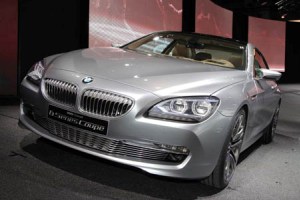
BMW 6 Series Concept
This big BMW coupe squeaked onto our list, despite some serious reservations about the “concept” part of its name. What you’re looking at is the next 6 Series coupe, plain and simple. And to be honest, we love the end result. The awkward humps and bumps of the previous generation have been smoothed over and modernized.
The rear end of the 6 Series is particularly more refined (i.e., less lumpy) than the previous model. A more aggressive front end and sharp side creases add extra attitude. It might not be a concept in the strict sense of the term, though we can’t argue that the next 6 Series is going to be a looker.
Engine choices will include BMW’s 300-bhp single-turbo inline-6 and twin-turbocharged V-8. A highly tuned version of the turbo V-8 should find its way under the hood of the next M6. Look for the 6 Series to arrive in the U.S. next year, and looking exactly like this concept version.
Kia Pop
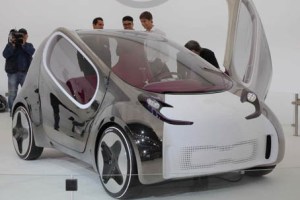
Kia Pop
To prove that we have sense of humor—and admire a healthy dose of bravery—we simply had to include the Kia Pop electric car. Okay, we’d prefer to see the Lamborghini Sesto Elemento or Jaguar C-X75 parked in our driveway. But if electric cars represent the future, let’s at least have some fun until we get there.
Whereas the upcoming Nissan Leaf EV was kept almost painfully bland—so as not to alienate everyone but the hippest of tech-loving early-adopters—the Kia Pop is anything but a shrinking violet, despite its tiny size. Yes, the chrome finish of this concept would make keeping it clean a nightmare. Yet we couldn’t help but smile at those wacky-looking side windows and doors that swing up and out.
The purple interior takes some serious getting used to. So would an estimated top speed of only 87 mph and a driving range of 100 miles. The Kia Pop EV is far from perfect and definitely risky. But isn’t that what concept cars should be all about?
Audi eTron Spyder Concept
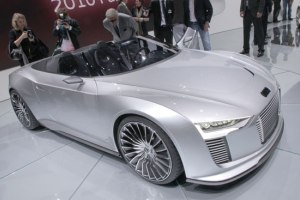
Audi eTron Spyder Concept
This is the open-top version of the 2-seat eTron coupe shown earlier this year at Detroit. The Spyder features a cut-down windscreen and is actually a plug-in hybrid with a mid-mounted 300-bhp twin-turbo V-6 diesel to boost power and extend the vehicle’s range. Weighing just 3196 lb., the eTron has two electric motors that propel this sports car to 62 mph in 4.4 seconds, while top speed is electronically limited to 155 mph. In pure electric mode, the eTron has a range of about 30 miles, while the diesel enables the vehicle to travel more than 600 miles before refueling.
Renault DeZir Concept

Renault DeZir Concept
This first show car from Renault’s new design director Lauren van der Acker is a 2-seat pure electric sports car called the DeZir. The capital Z in the name refers to Renault’s new ZE line of electric motors—in this case it’s a 150-hp unit that accelerates the 1800-lb. car to 62 mph in about 5 seconds. Contributing to the car’s light weight is its Kevlar body, and the sleek shape gives the car an ultra-low 0.25 coefficient of drag. The rear-drive DeZir has a range of about 100 miles between charges. The car is also equipped with a Kinetic Energy Recover System (KERS) developed by the Renault Formula 1 team that provides regenerative braking.
Exagon Furtive-eGT
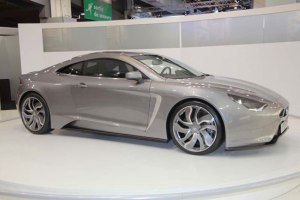
Exagon Furtive-eGT
The latest entry into the range-extended sporty car market is the French-built Exagon Furtive-eGT, which is slated to go into limited production in 2012. Powered by lithium-ion batteries, the Furtive-eGT has an electric-only range of 160 to 250 miles, while an optional gas engine can extend that range to 500 miles. Exagon says the car is capable of 0 to 62 mph acceleration of 3.5 seconds and that the car has a top speed of 178 mph. The company hopes to build about 100 cars a year when it goes into full production. Unlike most EVs that use the motors to directly drive the wheels, the Furtive-eGT uses a 3-speed paddle-shift gearbox attached to a mechanical auto-locking differential.
Read more...

















